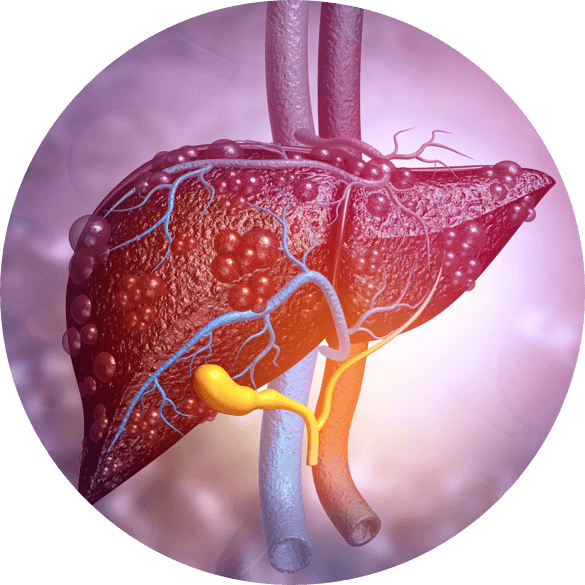Intended for licensed healthcare professionals located in Sweden.
FGFR2 fusion testing


Molecular profiling for the treatment of cholangiocarcinoma
Genomic alterations such as chromosomal translocations and fusions contribute to malignant transformation.1
Genomic studies reveal that ~50% of patients with cholangiocarcinoma (CCA) have actionable alterations, including fibroblast growth factor receptor 2 (FGFR2) fusions or rearrangements.2
FGFR2 fusions/rearrangements are strong oncogenic drivers.3 FGFR2 fusions/rearrangements occur in ~9% of intrahepatic cholangiocarcinoma (iCCA) cases.4
- FGFR2 fusions are detectable early in disease progression and are key drivers of tumour growth.5,6
- Molecular profiling is necessary to identify FGFR2 fusions and rearrangements.1,5,6
Methodologies to determine FGFR alterations
Genomic alterations with potential therapeutic implication are frequently found in patients with CCA,2 supporting the rationale for molecular profiling at diagnosis. A variety of molecular profiling methods are now available, with next-generation sequencing (NGS) and fluorescence in situ hybridisation (FISH) among the most common assays.2,7,8
NGS allows the opportunity to analyse a tissue sample for multiple alterations at the same time. Although the specimen size for NGS is initially larger and the turnaround time can be longer than for other methodologies, its more extensive coverage of genes of interest can be an advantage.9-11
FISH was originally designed to identify one specific, predetermined alteration at a time. Although multigene FISH assays can detect multiple prespecified genetic alterations, NGS may provide additional, non-prespecified information not possible to detect through FISH.7,8
FGFR2 fusions have a wide range of fusion partners.2 Therefore, to identify patients with FGFR2 fusions, it is important to select an assay that:
- Can detect FGFR2 fusions (which are distinct from FGFR2 point mutations).1,12,13
- Can detect all FGFR2 fusions, including those with known or unknown fusion partners (ie, FGFR2 fusion-partner agnostic).1,12,13
The European Society for Medical Oncology (ESMO) recommends parallel sequencing of several genes using focused NGS over single gene testing in patients with advanced disease.14

- Jain A, Borad MJ, Kelley RK, Wang Y, Abdel-Wahab R, Meric-Bernstam F, et al. Cholangiocarcinoma with FGFR genetic aberrations: a unique clinical phenotype. JCO Precis Oncol. 2018; 2:1–12.
- Lowery MA, Ptashkin R, Jordan E, Berger MF, Zehir A, Capanu M, et al. Comprehensive molecular profiling of intrahepatic and extrahepatic cholangiocarcinomas: potential targets for intervention. Clin Cancer Res. 2018 Sep 1; 24(17):4154–61.
- PEMAZYRE® (pemigatinib). Summary of product characteristics: Section 5.1 on www.fass.se.
- Kendre G, Murugesan K, Brummer T, Segatto O, Saborowski A and Vogel A. Charting co-mutation patterns associated with actionable drivers in intrahepatic cholangiocarcinoma. J Hepatol. 2023 Mar;78(3):614–26.
- Arai Y, Totoki Y, Hosoda F, Shirota T, Hama N, Nakamura H, Ojima H, et al. Fibroblast growth factor receptor 2 tyrosine kinase fusions define a unique molecular subtype of cholangiocarcinoma. Hepatology. 2014 Apr; 59(4):1427–34.
- Borad MJ, Gores GJ, Roberts LR. Fibroblast growth factor receptor 2 fusions as a target for treating cholangiocarcinoma. Curr Opin Gastroenterol. 2015 May; 31(3):264‑8.
- Dudley JC, Zheng Z, McDonald T, Le LP, Dias-Santagata D, Borger D, Batten J, et al. Next-generation sequencing and fluorescence in situ hybridization have comparable performance characteristics in the analysis of pancreaticobiliary brushings for malignancy. J Mol Diagn. 2016 Jan; 18(1):124–30.
- Hu L, Ru K, Zhang L, Huang Y, Zhu X, Liu H, et al. Fluorescence in situ hybridization (FISH): an increasingly demanded tool for biomarker research and personalized medicine. Biomark Res. 2014 Feb 5; 2(1):3.
- Cree IA, Deans Z, Ligtenberg MJ, Normanno N, Edsjö A, Rouleau E, et al. Guidance for laboratories performing molecular pathology for cancer patients. J Clin Pathol. 2014 Nov; 67(11):923–31.
- Damodaran S, Berger MF, Roychowdhury S. Clinical tumor sequencing: opportunities and challenges for precision cancer medicine. Am Soc Clin Oncol Educ Book. 2015; e175–82.
- Su D, Zhang D, Chen K, Lu J, Wu J, Cao X, et al. High performance of targeted next generation sequencing on variance detection in clinical tumor specimens in comparison with current conventional methods. J Exp Clin Cancer Res. 2017 Sep 7; 36(1):121.
- Silverman IM, Hollebecque A, Friboulet L, Owens S, Newton RC, Zhen H, et al. Clinicogenomic analysis of FGFR2-rearranged cholangiocarcinoma identifies correlates of response and mechanisms of resistance to pemigatinib. Cancer Discov. 2021 Feb; 11(2):326–39.
- Barr FG. Fusion genes in solid tumors: the possibilities and the pitfalls. Expert Rev Mol Diagn. 2016 Sep; 16(9):921–3.
- Vogel A, Bridgewater J, Edeline J, Kelley RK, Klümpen HJ, et al. Biliary tract cancer: ESMO Clinical Practice Guideline for diagnosis, treatment and follow-up. Ann Oncol. 2023 Feb;34(2):127–40.




